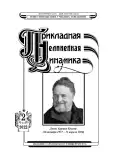Nonlinear amplification of the magnetic induction signal in a magnetomodulation sensor with an amorphous ferromagnetic core
- Authors: Sokol-Kutylovskii O.L.1
-
Affiliations:
- Yu. P. Bulashevich Institute of Geophysics, Ural Branch of the Russian Academy of Sciences
- Issue: Vol 30, No 2 (2022)
- Pages: 233-238
- Section: Articles
- URL: https://journals.rcsi.science/0869-6632/article/view/252094
- DOI: https://doi.org/10.18500/0869-6632-2022-30-2-233-238
- ID: 252094
Cite item
Full Text
Abstract
About the authors
Oleg Leonidovich Sokol-Kutylovskii
Yu. P. Bulashevich Institute of Geophysics, Ural Branch of the Russian Academy of Sciences620016, Yekaterinburg, st. Amundsen, 100
References
- Поляков С. В., Резников Б. И., Щенников А. В., Копытенко Е. А., Самсонов Б. В. Линейка индукционных датчиков магнитного поля для геофизических исследований // Сейсмические приборы. 2016. Т. 52, № 1. С. 5-27.
- Janosek M., Butta M., Dressler M., Saunderson E., Novotny D., Fourie C. 1-pT noise fluxgate magnetometer for geomagnetic measurements and unshielded magnetocardiography // IEEE Transactions on Instrumentation and Measurement. 2020. Vol. 69, no. 5. P. 2552-2560. doi: 10.1109/TIM.2019.2949205.
- Fescenko I., Jarmola A., Savukov I., Kehayias P., Smits J., Damron J., Ristoff N., Mosavian N., Acosta V. M. Diamond magnetometer enhanced by ferrite flux concentrators // Physical Review Research. 2020. Vol. 2, no. 2. P. 023394. doi: 10.1103/PhysRevResearch.2.023394.
- Yang K., Chen H., Lu L., Kong X., Yang R., Wang J. SQUID array with optimal compensating configuration for magnetocardiography measurement in different environments // IEEE Transactions on Applied Superconductivity. 2019. Vol. 29, no. 6. P. 1600707. doi: 10.1109/TASC.2019.2904483.
- Faley M. I., Maslennikov Y. V., Koshelets V. P., Dunin-Borkowski R. E. Flip-chip high-Tc dc SQUID magnetometer with a ferromagnetic flux antenna // IEEE Transactions on Applied Superconductivity. 2018. Vol. 28, no. 4. P. 1600505. doi: 10.1109/TASC.2018.2791414.
- Сокол-Кутыловский О. Л. О влиянии механического напряжения на ленты аморфных ферромагнитных сплавов // Деп. ВИНИТИ. 2002. № 1338-В2002. 9 с.
- Sokol-Kutylovskii O. L. A magneto-modulating meter of a weak variable magnetic field // Instruments and Experimental Techniques. 2019. Vol. 62, no. 4. P. 554-557. doi: 10.1134/S0020441219040110.
Supplementary files










